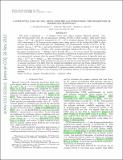| dc.contributor.author | Prochaska, J. Xavier | |
| dc.contributor.author | Hennawi, Joseph F. | |
| dc.contributor.author | Simcoe, Robert A. | |
| dc.date.accessioned | 2013-01-25T19:56:35Z | |
| dc.date.available | 2013-01-25T19:56:35Z | |
| dc.date.issued | 2012-12 | |
| dc.date.submitted | 2012-11 | |
| dc.identifier.issn | 2041-8205 | |
| dc.identifier.issn | 2041-8213 | |
| dc.identifier.uri | http://hdl.handle.net/1721.1/76614 | |
| dc.description.abstract | The hosts of luminous z ~ 2 quasars evolve into today's massive elliptical galaxies. Current theories predict that the circumgalactic medium (CGM) of these massive, dark matter halos (M [subscript DM] ~ 10[superscript 12.5] M [subscript ☉]) should be dominated by a T ~ 10[superscript 7] K virialized plasma. We test this hypothesis with observations of 74 close-projected quasar pairs, using spectra of the background QSO to characterize the CGM of the foreground one. Surprisingly, our measurements reveal a cool (T ≈ 10[superscript 4] K), massive (M [subscript CGM] > 10[superscript 10] M [subscript ☉]), and metal-enriched (Z ≳ 0.1 Z [subscript ☉]) medium extending to at least the expected virial radius (r [subscript vir] = 160 kpc). The average equivalent widths of H I Lyα ([_ over W] [subscript [subscript Lyα] = 2.1 ± 0.15 Å for impact parameters R ⊥ < 200 kpc) and C II 1334 ([_ over W][subscript 1334] = 0.7 ± 0.1) exceed the corresponding CGM measurements of these transitions from all galaxy populations studied previously. Furthermore, we conservatively estimate that the quasar CGM has a 64[superscript +6] [subscript –7]% covering fraction of optically thick gas (N [subscript H I] > 10[superscript 17.2] cm[superscript –2]) within r [subscript vir]; this covering factor is twice that of the contemporaneous Lyman break galaxy population. This unexpected reservoir of cool gas is rarely detected "down-the-barrel" to quasars, and hence it is likely that our background sight lines intercept gas that is shadowed from the quasar ionizing radiation by the same obscuring medium often invoked in models of active galactic nucleus unification. Because the high-z halos inhabited by quasars predate modern groups and clusters, these observations are also relevant to the formation and enrichment history of the intragroup/intracluster medium. | en_US |
| dc.language.iso | en_US | |
| dc.publisher | IOP Publishing | en_US |
| dc.relation.isversionof | http://dx.doi.org/10.1088/2041-8205/762/2/L19 | en_US |
| dc.rights | Creative Commons Attribution-Noncommercial-Share Alike 3.0 | en_US |
| dc.rights.uri | http://creativecommons.org/licenses/by-nc-sa/3.0/ | en_US |
| dc.source | arXiv | en_US |
| dc.title | A Substantial Mass of Cool, Metal-enriched Gas Surrounding the Progenitors of Modern-day Ellipticals | en_US |
| dc.type | Article | en_US |
| dc.identifier.citation | Xavier Prochaska, J., Joseph F. Hennawi, and Robert A. Simcoe. “A SUBSTANTIAL MASS OF COOL, METAL-ENRICHED GAS SURROUNDING THE PROGENITORS OF MODERN-DAY ELLIPTICALS.” The Astrophysical Journal 762.2 (2013): L19. | en_US |
| dc.contributor.department | Massachusetts Institute of Technology. Department of Physics | en_US |
| dc.contributor.department | MIT Kavli Institute for Astrophysics and Space Research | en_US |
| dc.contributor.mitauthor | Simcoe, Robert A. | |
| dc.relation.journal | Astrophysical Journal. Letters | en_US |
| dc.eprint.version | Author's final manuscript | en_US |
| dc.type.uri | http://purl.org/eprint/type/JournalArticle | en_US |
| eprint.status | http://purl.org/eprint/status/PeerReviewed | en_US |
| dspace.orderedauthors | Xavier Prochaska, J.; Hennawi, Joseph F.; Simcoe, Robert A. | en |
| dc.identifier.orcid | https://orcid.org/0000-0003-3769-9559 | |
| mit.license | OPEN_ACCESS_POLICY | en_US |
| mit.metadata.status | Complete | |
